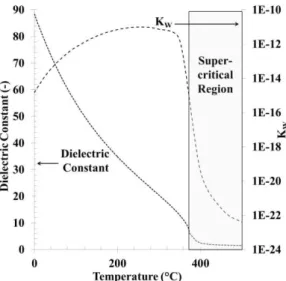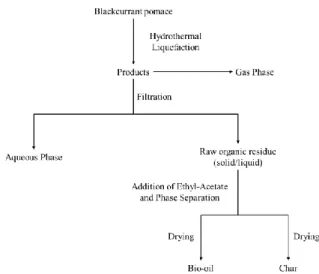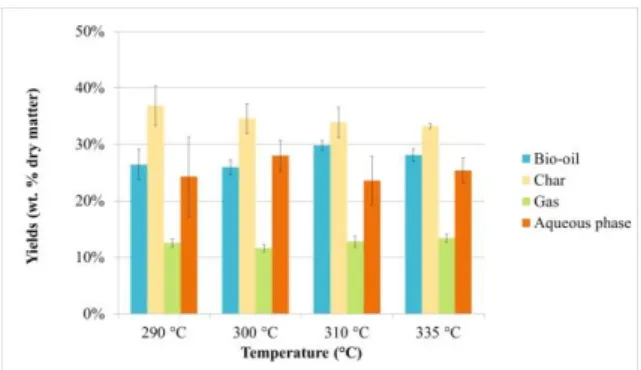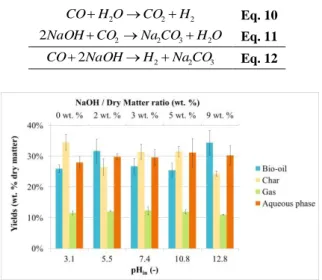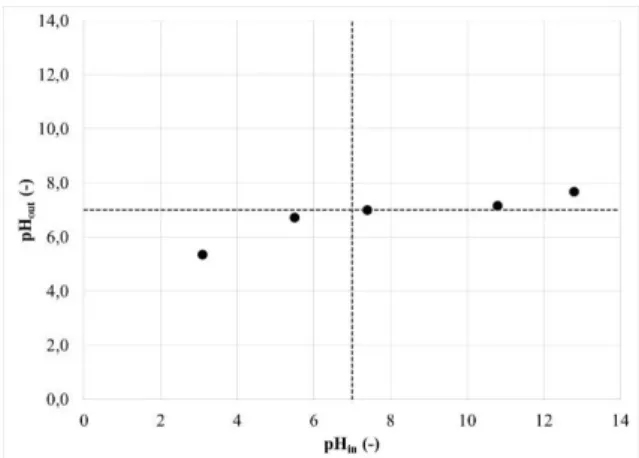HAL Id: hal-01509377
https://hal-mines-albi.archives-ouvertes.fr/hal-01509377v2
Submitted on 8 Aug 2017
HAL is a multi-disciplinary open access
archive for the deposit and dissemination of
sci-entific research documents, whether they are
pub-lished or not. The documents may come from
teaching and research institutions in France or
abroad, or from public or private research centers.
L’archive ouverte pluridisciplinaire HAL, est
destinée au dépôt et à la diffusion de documents
scientifiques de niveau recherche, publiés ou non,
émanant des établissements d’enseignement et de
recherche français ou étrangers, des laboratoires
publics ou privés.
Maxime Deniel, G Haarlemmer, A Roubaud, Elsa Weiss-Hortala, Jacques
Fages
To cite this version:
Maxime Deniel, G Haarlemmer, A Roubaud, Elsa Weiss-Hortala, Jacques Fages.
Hydrother-mal Liquefaction of Food Processing Residues :
Application to the Blackcurrant Pomace.
23rd European Biomass Conference and Exhibition, Jun 2015, Vienne, Austria.
pp.928-934,
�10.5071/23rdEUBCE2015-3AO.6.3�. �hal-01509377v2�
HYDROTHERMAL LIQUEFACTION OF FOOD PROCESSING RESIDUES: APPLICATION TO BLACKCURRANT POMACE
M. Déniela,b,*, G. Haarlemmera, A. Roubauda,E. Weiss-Hortalab, J. Fagesb
a CEA-LITEN/Laboratoire de Thermoconversion des Bioressources 17 rue des Martyrs 38054 Grenoble CEDEX 9, France b Université de Toulouse, Ecole des Mines d'Albi, CNRS Centre RAPSODEE, 81013 ALBI, France
* Corresponding Author: – Maxime.Deniel@cea.fr, Tel. 0033438784026, Fax 0033438785251
ABSTRACT: This study reports hydrothermal liquefaction of blackcurrant pomace to produce bio-oil, focusing on the influence of several process parameters on yields and carbon distribution between phases: holding time (0-240 min), temperature (290-335°C), and addition of sodium hydroxide NaOH to vary the initial pH (3.1-12.8). Bio-oil yields up to 34 wt. % on a dry matter basis were obtained. An optimum temperature of 310°C corresponding to 30 wt. % bio-oil yield was observed, while higher temperatures decrease bio-oil recovery. At 300°C, holding time does not have a significant influence on the results: short holding times already achieve biomass conversion and relatively high bio-oil yields. Finally, increasing the initial pH of the feed by addition of NaOH inhibits char formation and enhances the bio-oil yield as well as the transfer of carbon to the aqueous phase. The char yield drops from 35 wt. % at pH = 3.1 (case without NaOH) to 24 wt. % at pH = 12.8 (corresponding to a NaOH/dry matter ratio of 9 wt. %). At the same time, the fraction of carbon remaining in the aqueous phase increases from 12 wt. % at pH = 3.1 to 25 wt. % at pH = 12.8.
Keywords: Hydrothermal liquefaction, food processing residues, bio-oil, batch reactor
1 INTRODUCTION
Access to energy is a strategic issue in our modern societies, getting more and more important as the world population is growing. In fact, our economies are based on fossil resources such as coal and crude oil, which represent more than 80% of the energy production in the world [1]. The exploitation of such non-renewable resources will lead to a rise in prices and to the depletion of fossil fuels within a few decades. Alternatives should then be found to meet our needs for energy and products. For the future, the use of biomass could provide for these needs, as it is a renewable, highly available and carbon neutral source of energy.
A vast portion of biomass is wet organic waste from agriculture and food processing industries, produced during the transformation of animal and vegetal material. Each year, around 1.6 billion tons of organic material are lost along the food supply chain, which represents more than 20% of the total agricultural production in the world [2]. They consequently are a widely available source for valorisation, and modern centralised production techniques make it interesting to consider organic waste for energy production. Using them as a raw material also allows reducing the footprint of human activities on the environment, since they can cause environmental problems: contribution to the greenhouse effect by methane and carbon dioxide emissions, contamination of soils and groundwater, etc. As well, they can lead to sanitary problems impacting human health.
Due to their potential for recovering high-value compounds and bio-based fuels, food processing wastes gained a growing interest in recent years. In particular, fruit processing residues are relevant for valorisation, because this industry is one of the main producers of food wastes: up to 50 wt. % of fruits and vegetables are lost along the food supply chain [3]. Biochemical and thermochemical processes are currently being developed for reusing food wastes in an efficient and environmental-friendly way, especially by converting them into renewable fuels.
Many thermochemical technologies exist, such as direct combustion to generate heat and electricity, gasification to produce synthesis gas and pyrolysis to produce liquid bio-oils. Most thermochemical processes
(combustion or gasification) require a biomass with a relatively low moisture content, generally less than 30 wt. %. Food processing residues have high moisture content, ranging from 50 wt. % to more than 95 wt. %. They consequently require a costly drying step, making them unsuitable for dry conversion routes. In this context, hydrothermal processes are promising leads for the valorisation of wet organic waste in an economical way, since they use water as both a reaction medium and a reactant. In particular, wet biomass can be directly transformed into liquid fuels by hydrothermal liquefaction.
Hydrothermal liquefaction, commonly referred to as HTL, is a process in which wet biomass is converted into a crude-like oil using subcritical water (T = 250-350°C, P = 10-30 MPa). Subcritical water corresponds to hot pressurised liquid water at temperatures between its atmospheric boiling point and its critical temperature. In these conditions, water loses its polarity, behaving similar to an organic solvent, and its ionic product Kw increases
up to three orders of magnitude (
Figure 1). This leads to better solubility of organic compounds and increased catalytic activities for acid-base reactions, such as hydrolysis of the bio-polymers contained in biomass [4]. HTL of biomass typically generates 4 products: a ‘bio-oil’ with higher heating values up to 35-40 MJ/kg, an aqueous phase containing light polar organics, a solid residue called ‘char’ and a CO2-rich gaseous phase.
To date, a limited number of studies has focused on hydrothermal liquefaction of food processing residues, and only few studies focus on fruit and vegetable processing wastes [5-11]. Depending on the resource and the experimental procedures, a great variability in the results of hydrothermal liquefaction is observed in the literature. Studies on substrates of specific compositions are therefore necessary for screening and comparison purposes. The objective of the present paper is to study the influence of operating parameters on hydrothermal liquefaction of blackcurrant pomace. Blackcurrant pomace was chosen as a reference biomass for studying hydrothermal liquefaction of fruit processing residues. In this paper, we report the influence of operating temperature, holding time and addition of sodium hydroxide NaOH to vary the initial pH of the feed.
Figure 1: Evolution of water properties at P = 25 MPa as
a function of temperature
2 MATERIALS AND METHODS 2.1 Materials
The experiments were performed using blackcurrant pomace supplied by a local manufacturer as the substrate. Table I gives the typical composition and Higher Heating Value (HHV) of the biomass used in this study, obtained from external analysis laboratories. Pellets of Sodium Hydroxide NaOH were purchased from Merck and used as received. For each experiment, distilled water was used.
Table I: Composition and HHV of blackcurrant pomace Blackcurrant Pomace
Moisture content (wt. %) 59.6
Fibre content (wt. % dry matter)
NDF 61.7 ADF 52.8 ADL 35.4
Proteins (wt.% dry matter) 16.9
Lipids (wt. % dry matter) 3.5
Ash content at 550°C (wt.% dry matter) 4.5 Elemental composition (wt. % dry matter) C 50.3 H 6.8 O 38.9 N 1.9 S 0.2 HHV (MJ/kg) 18.51
2.2 Hydrothermal liquefaction experiments
Hydrothermal liquefaction experiments were performed in a 0.6 L stainless steel (SS316) stirred batch reactor (Parr Instruments). In a typical experiment, the reactor was filled with approximately 240 g of biomass slurry prepared from raw blackcurrant pomace, distilled water and a certain amount of sodium hydroxide NaOH when needed. A constant 14 wt. % dry biomass to water ratio was maintained. Before each experiment, pH was measured (Scientific Instruments IQ170 pH meter). The initial pH of the mixture was about 3.1 when no additive
was added to the feed. The autoclave was leak tested, purged and pressurised to 1 MPa with nitrogen gas to guarantee sufficient pressure for gas analysis after the reaction. The total pressure inside the reactor was a function of the initial nitrogen pressure, the reaction temperature and the amount of water. The reactor was heated from room temperature to the reaction temperature in about 35-40 min. Once the reactor reached the reaction temperature, it was held during a specified time within ± 1°C of the reaction temperature (holding time). A stirring speed of 600 rpm was set. After the holding time, the reactor was rapidly cooled to room temperature in 20 min by an air quench. The gas in the reactor was vented and analysed by a micro-chromatograph (Varian Quad CP 4900) used in line. Permanent gases (O2, H2, CO and
CH4) were analysed by a molecular sieve column using
argon as carrier gas. Light hydrocarbons (C2H4, C2H6,
C2H2 and C3H8), CO2 and sulphur species (H2S and COS)
were analysed on a Poraplot-U column using helium as carrier gas. The quantity of gas formed during the experiment was calculated using initial and final temperatures and pressures, and the composition of the gas phase obtained by micro-chromatography. Solid and liquid products were then recovered following the recovery procedure described in paragraph 2.3.
2.3 Recovery procedure and analysis of the products After gas analysis, the reactor was opened and the products were recovered following the procedure given in Figure 2. The content of the reactor was first filtered on a Buchner filter to separate the aqueous phase from the raw organic residue. The raw residue was sticky, and removed from the reactor as best as possible. The reactor was then weighed and the weight difference with the empty reactor was counted as raw organic residue (wet). Moisture content of the raw residue (WR) was estimated
using two methods: drying at room temperature under air circulation until a stable mass was obtained, and Karl Fischer titration using a Schott Instruments Titroline KF.
The raw organic residue was then extracted using a tenfold amount of ethyl acetate to separate the bio-oil from the char on a Buchner filter. Bio-oil was recovered after evaporation of ethyl acetate at room temperature under air circulation overnight until a stable weight was obtained. An estimation of the residual solvent amount in the bio-oil was performed by subjecting pure ethyl acetate to the same procedure, and only traces of ethyl acetate were left after 24h of evaporation. It was therefore assumed that no residual solvent was left in the bio-oil. The char was also dried overnight at room temperature under air circulation until a stable weight was obtained. Weight loss of the char after extraction and drying was used to determine the proportion of solvent-soluble organics in the raw organic residue (SSO), and therefore the bio-oil yield.
Total carbon of the solid and oil samples were quantified by a total organic carbon analyser (Shimadzu SSM-5000A). Total carbon of the aqueous phase (CTA)
was quantified by a total organic carbon analyser (Shimadzu TOC-L CSH/CSN).
Figure 2: Recovery procedure for products after
hydrothermal liquefaction of blackcurrant pomace 2.4 Calculation of the yields
Yields are calculated from the obtained experimental results. They are defined as the mass ratio between the recovered phases and the dry biomass before the experiment. Due to the many steps in the experimental procedures, it can be tricky to accurately quantify the yields of the products. It is custom to calculate one yield from others by closing the mass balance to 100%.
The bio-oil and char yields are calculated using the results from solvent extraction. The gas yield is calculated using initial and final temperatures and pressures, and the composition of the gas phase obtained by micro-chromatography. The aqueous phase yield is calculated by difference, closing the mass balance to 100%. Calculation of the yields is done according to the following formulation: m ) W -(SSO m Y BC R BO R Eq. 1 m ) SSO -(1 m Y BC R C Eq. 2 m m Y BC G G Eq. 3 Y Y YBO C G 100% YA Eq. 4
2.5 Calculation of the carbon distribution
Carbon recoveries are defined as the ratio between the mass of carbon contained in the recovered phases and the initial mass of carbon in the biomass:
m C m C CR BC BC BO BO BO Eq. 5 m C C CR BC BC C C mC Eq. 6 BC BC G G m C m C CRG Eq. 7 BC BC A A m C CT V CRA Eq. 8
Error bars presented in the following section are the standard deviations corresponding to replications of the experiments.
3 RESULTS AND DISCUSSION 3.1 Effect of operating temperature
Temperature is often considered as one of the most influent operating parameters on HTL of biomass. The effect of operating temperature on HTL of blackcurrant pomace was thus evaluated with a fixed 60 min holding time. Operating temperatures were varied from 290°C to 335°C. Results of the experiments are reported in Figure 3 and Figure 4. Table II reports the carbon balances of each experiment. They vary from 92.6 wt. % to 109.9 wt. %, mainly due to experimental error. Inaccuracies in the estimation of the moisture content of the raw organic residue can lead to a bad estimation of the quantity of bio-oil. Carbon content in the bio-oil may also be inaccurate due to the loss of volatiles during evaporation of ethyl acetate.
The results show that increasing the temperature from 290°C to a temperature of 310°C enhances the bio-oil yield and carbon recovery in the bio-oil. Higher temperatures lead to a decrease of the bio-oil yield and to a slight increase of gas formation. This is consistent with most published studies in the literature [12] and corresponds to the pathway of bio-oil formation in subcritical water. According to Matsumura et al. [13], bio-oil formation occurs first through biomass hydrolysis, leading to depolymerisation of biopolymers and generation of monomers in the reaction medium (e.g. sugars). These single units degrade subsequently to give light polar molecules found in the aqueous phase, as well as bio-oil through condensation reactions. Gaseous products mainly originate either from degradation of water-soluble products (decarboxylation, decarbonylation) or from bio-oil decomposition [14]. The optimum temperature of 310°C might be due to the relatively high lignin content of blackcurrant pomace, as shown in Table I (ADL content = 35.4 wt. % of the dry matter). In fact, lignin requires higher temperatures than cellulosic polymers to be degraded and form bio-oil.
Further increase in temperature to 335°C lowers the bio-oil yield. This observation might be due to fragmentations reactions yielding more gas by decarboxylation, decarbonylation and Water-Gas-Shift reactions, as well as re-polymerisation of reactive intermediates at higher temperatures to form char.
During HTL of blackcurrant pomace, the bio-oil yield first increases with the increase in conversion temperatures, and then decreases, probably due to gas formation by fragmentation reactions and to char formation by re-polymerisation reactions. The results illustrate the synergetic effect between high dissociation of water and thermal activation of bond-cleavage; temperature has to be high enough to ensure that biopolymers such as cellulose and lignin are hydrolysed and participate in bio-oil formation.
Figure 3: Yields of products obtained by HTL of
blackcurrant pomace at various operating temperatures (holding time = 60 min)
Figure 4: Carbon distribution in products obtained by
HTL of blackcurrant pomace at various operating temperatures (holding time = 60 min)
Table II: Carbon balances for HTL of blackcurrant
pomace at various operating temperatures (holding time = 60 min)
Temperature (°C) Carbon balance (wt. % Cin)
290°C 92.6 300°C 103.5 310°C 109.9 335°C 101.6
3.2 Effect of holding time
The effect of holding time on HTL of blackcurrant pomace was evaluated with a fixed operating temperature of 300°C. Holding times were varied from 0 min (end of the heating time) to 240 min. Results of the experiments are reported in Figure 5 and Figure 6. Table III reports the carbon balances corresponding to each experiment. They vary from 93.5 wt. % to 112.5 wt. %, mainly due to experimental error as for the experiments with temperature.
The results show that no clear tendency arises from the experiments with different holding times. This may be due to the relatively long heating time of the batch reactor, indicating that the majority of reactions occurred in the early stages of the process. It indicates that hydrothermal liquefaction of blackcurrant pomace occurs rapidly. Short holding times already achieve biomass conversion and further evolutions may be the results of competing reactions such as fragmentations and condensations impacting bio-oil and char. Achieving high bio-oil yields in short residence times is particularly important when considering development of a continuous process.
Figure 5: Yields of products obtained by HTL of
blackcurrant pomace at various holding times (operating temperature = 300 °C)
Figure 6: Carbon distribution in products obtained by
HTL of blackcurrant pomace at various holding times (operating temperature = 300°C)
Table III: Carbon balances for HTL of blackcurrant
pomace at various holding times (operating temperature = 300 °C)
Holding time (min) Carbon balance (wt. % Cin)
0 112.5 10 103.3 15 99.4 30 112.5 60 103.5 240 93.5
3.3 Effect of addition of sodium hydroxide NaOH Alkali catalysts are often used to improve the bio-oil yields, by carrying out hydrothermal liquefaction in basic medium. Alkali catalysts such as NaOH and Na2CO3 are
often used to reduce the char yield and enhance bio-oil formation, by stabilising reactive intermediates and inhibiting secondary condensation reactions leading to polymeric char [14-17].
The effect of using NaOH to vary the initial pH of the feed was therefore evaluated with a fixed operating temperature of 300°C and a fixed holding time of 60 min. Initial pH ranged from 3.1 (initial pH without NaOH) to 12.8 (corresponding to a NaOH/dry matter ratio of 9 wt. %). Results of the experiments are reported in Figure 7 and Figure 8. Table IV reports the carbon balances of each experiment. They vary from 101.4 wt. % to 112.5 wt. %, mainly due to experimental error as for other experiments reported in this study.
The results show that using NaOH leads to an important reduction of the char yield, corresponding to higher solubilisation of the organic matter in the aqueous phase. In fact, carbon recovery increases from 12 wt. %
of the initial carbon at pHin = 3.1 (case without NaOH),
to 25 wt. % of the initial carbon at pHin = 12.8
(corresponding to a NaOH/dry matter ratio of 9 wt. %). This observation means that more water-soluble molecules are formed when the initial pH of the feed increases, and is consistent with results reported elsewhere in the literature [18-24].
The decrease of the amount of char in favour of the organic content of the aqueous phase is mainly due to two beneficial effects of NaOH for HTL. Firstly, hydroxide ions neutralise the carboxylic acids formed during hydrothermal conversion of biomass. Carboxylic acids thus remain in the aqueous phase as carboxylate ions, as shown in Equation 9. This is illustrated by the decrease of the pH of the aqueous phase after the reaction (Figure 9). It has been observed that polymerisation reactions can occur between carboxylic groups in the aqueous phase and hydroxyl groups at the surface of the residue, forming ester bonds and yielding more char [25]. Therefore, using NaOH avoids polymerisation because carboxylic acids are neutralised and cannot participate in condensation reactions [25, 26]. O H Na RCO NaOH H RCO2 2 2 Eq. 9
Secondly, the use of NaOH influences the reaction pathways taking place in subcritical water, depending on the biomass composition. As shown in Table I, blackcurrant pomace is mainly composed of fibres, with a total fibre (NDF) content representing 61.7 wt. % of the total dry matter. Especially, the ADF and ADL contents are high, meaning that the fibres are both rich in cellulose and lignin. Hydrothermal liquefaction of cellulosic polymers produces sugar degradation products: furans, aldehydes, ketones and carboxylic acids [27-29]. Particularly, acidic conditions will drive the reaction mechanism towards dehydration of sugars, forming mainly furan derivatives such as 5-HMF and furfural which could polymerise and increase char formation. With increasing pH, reaction mechanisms shift to fragmentations such as retro-aldol condensations, leading to the formation of short-chain polar compounds, soluble in water: aldehydes, ketones, and ultimately carboxylic acids.
While lignin is poorly reactive in acidic conditions, base-catalysed hydrolysis with sodium hydroxide is an efficient way to achieve depolymerisation and yield phenol monomers and dimers in the aqueous phase [23, 24]. Base-catalysed depolymerisation of the high amount of lignin contained in blackcurrant pomace through hydrolysis could help understanding the better degradability of biomass in basic medium and the increased solubilisation of organic matter in the aqueous phase. In fact, the seeds are lignin-rich, and using NaOH allows good degradation of these particular structures, as shown in Figure 10. In presence of NaOH, the seeds develop a porous surface: the formation of pores could enhance the liberation of reserve molecules such as proteins and fatty acids contained in the endosperm of the seed, which are important contributors to the bio-oil yield.
Inhibition of char formation can also be explained by the fact that using NaOH provides a more reductive reaction medium than in acidic conditions. In fact, NaOH favours the Water-Gas shift reaction, by reacting with CO2 and moving forward the equilibrium towards H2
formation (Equations 10 to 12). At the same time, it
favours decarboxylation reactions, which enhance the quality of the bio-oil. We observed in our experiments a large increase of the amount of H2 produced in the gas
phase, which shows the positive effect of NaOH on the Water-Gas-Shift reaction. 2 2 2O CO H H CO Eq. 10 O H CO Na CO NaOH 2 2 3 2 2 Eq. 11 3 2 2 2NaOH H NaCO CO Eq. 12
Figure 7: Yields of products obtained by HTL of
blackcurrant pomace at various initial pH of the feed and NaOH loadings (operating temperature = 300 °C; holding time = 60 min)
Figure 8: Carbon distribution in products obtained by
HTL of blackcurrant pomace at various initial pH of the feed and NaOH loadings (operating temperature = 300 °C; holding time = 60 min)
Table IV: Carbon Balances for HTL of blackcurrant
pomace at various initial pH of the feed (operating temperature = 300 °C; holding time = 60 min)
pHin (-) Carbon balance (wt. % Cin) 3.1 103.5 5.5 104.9 7.4 108.8 10.8 101.4 12.8 112.5
Figure 9: Comparison of pH of aqueous phases after
HTL of blackcurrant pomace and initial pH of the feed
Figure 10: SEM images of (a) raw blackcurrant seed, (b)
after HTL at pHin = 5.5, (c,d) after HTL at pHin = 12.8
4 CONCLUSION
This study demonstrated the feasibility of applying HTL for producing bio-oil from biomass with high-fibre and low-lipid content. This is particularly interesting, considering the high amount of wet lignocellulosic wastes generated each year by agricultural production and food processing industries. Short holding times readily achieve biomass conversion and bio-oil recovery, and operating temperatures around 310°C enhance the bio-oil yield. We also showed the positive effect of sodium hydroxide to reduce the char amount and increase bio-oil formation. This is due both to a better degradability of blackcurrant pomace in alkaline conditions and to the inhibition of char formation by stabilising reactive intermediates. This study allowed the identification of process parameters that should now be tested under continuous conditions, to avoid the negative effect of long heating and cooling times in batch mode.
5 NOMENCLATURE
YBO Bio-oil yield (wt. % of dry blackcurrant pomace)
YC Char yield (wt. % of dry blackcurrant pomace)
YG Gas yield (wt. % of dry blackcurrant pomace)
YA Aqueous phase yield (wt. % of dry blackcurrant
pomace)
CRBO Carbon recovery in bio-oil (wt. % of initial
carbon in blackcurrant pomace) CRC Carbon recovery in char (wt. % of initial carbon
in blackcurrant pomace)
CRG Carbon recovery in gas (wt. % of initial carbon
in blackcurrant pomace)
CRA Carbon recovery in aqueous phase (wt. % of
initial carbon in blackcurrant pomace) CBC Carbon content in blackcurrant pomace (wt. %)
CBO Carbon content in bio-oil (wt. %)
CC Carbon content in char (wt. %)
CG Carbon content in gas (wt. %)
mBC Mass of dry blackcurrant pomace (g)
mR Mass of raw organic residue (g)
mBO Mass of bio-oil (g)
mC Mass of char (g)
mG Mass of gas (g)
VA Volume of aqueous phase (L)
SSO Rate of solvent-soluble organics (wt. %) WR Water content of raw organic residue (wt. %)
CTA Concentration of total carbon in aqueous phase
(g/L)
NDF Neutral Detergent Fibres
ADF Acid Detergent Fibres
ADL Acid Detergent Lignin
HTL Hydrothermal Liquefaction
6 REFERENCES
[1] IEA, Key World Energy Statistics, (2013), International Energy Agency: France.
[2] FAO, Food wastage footprint: Impacts on natural resources, (2013).
[3] FAO, Global Initiative on Food Loss and Waste Reduction, (2014).
[4] Weingärtner, H. and E.U. Franck, Supercritical Water as a Solvent, Angewandte Chemie International Edition, (2005), pag. 2672.
[5] Mazaheri, H., K.T. Lee, S. Bhatia, and A.R. Mohamed, Sub/supercritical liquefaction of oil palm fruit press fiber for the production of bio-oil: Effect of solvents, Bioresource Technology, (2010), pag. 7641.
[6] Akalın, M.K., K. Tekin, and S. Karagöz, Hydrothermal liquefaction of cornelian cherry stones for bio-oil production, Bioresource Technology, (2012), pag. 682.
[7] Salak, F., S. Daneshvar, J. Abedi, and K. Furukawa, Adding value to onion (Allium cepa L.) waste by subcritical water treatment, Fuel Processing Technology, (2013), pag. 86.
[8] Wang, F., Z. Chang, P. Duan, W. Yan, Y. Xu, L. Zhang, J. Miao, and Y. Fan, Hydrothermal liquefaction of Litsea cubeba seed to produce bio-oils, Bioresource Technology, (2013), pag. 509. [9] Goudriaan, F., B. van de Beld, F.R. Boerefijn,
G.M. Bos, J.E. Naber, S. van der Wal, and J.A. Zeevalkink, Thermal Efficiency of the HTU® Process for Biomass Liquefaction, in Progress in Thermochemical Biomass Conversion. (2008), Blackwell Science Ltd. pag. 1312.
[10] Liu, A., Y. Park, Z. Huang, B. Wang, R.O. Ankumah, and P.K. Biswas, Product Identification and Distribution from Hydrothermal Conversion of Walnut Shells, Energy & Fuels, (2006), pag. 446.
[11] Yedro, F.M., J. Garcia-Serna, D.A. Cantero, F. Sobron, and M.J. Cocero, Hydrothermal hydrolysis of grape seeds to produce bio-oil, RSC Advances, (2014), pag. 30332.
[12] Akhtar, J. and N.A.S. Amin, A review on process conditions for optimum bio-oil yield in hydrothermal liquefaction of biomass, Renewable and Sustainable Energy Reviews, (2011), pag. 1615.
[13] Matsumura, Y., T. Minowa, B. Potic, S.R.A. Kersten, W. Prins, W.P.M. van Swaaij, B. van de Beld, D.C. Elliott, G.G. Neuenschwander, A. Kruse, and M. Jerry Antal Jr, Biomass gasification in near- and super-critical water: Status and prospects, Biomass and Bioenergy, (2005), pag. 269.
[14] Yin, S., R. Dolan, M. Harris, and Z. Tan, Subcritical hydrothermal liquefaction of cattle manure to bio-oil: Effects of conversion parameters on bio-oil yield and characterization of bio-oil, Bioresource Technology, (2010), pag. 3657. [15] Toor, S.S., L. Rosendahl, and A. Rudolf,
Hydrothermal liquefaction of biomass: A review of subcritical water technologies, Energy, (2011), pag. 2328.
[16] Song, C., H. Hu, S. Zhu, G. Wang, and G. Chen, Nonisothermal Catalytic Liquefaction of Corn Stalk in Subcritical and Supercritical Water, Energy & Fuels, (2003), pag. 90.
[17] Karagöz, S., T. Bhaskar, A. Muto, and Y. Sakata, Hydrothermal upgrading of biomass: Effect of K2CO3 concentration and biomass/water ratio on products distribution, Bioresource Technology, (2006), pag. 90.
[18] Yin, S. and Z. Tan, Hydrothermal liquefaction of cellulose to bio-oil under acidic, neutral and alkaline conditions, Applied Energy, (2012), pag. 234.
[19] Watanabe, M., Y. Aizawa, T. Iida, T.M. Aida, C. Levy, K. Sue, and H. Inomata, Glucose reactions with acid and base catalysts in hot compressed water at 473K, Carbohydrate Research, (2005), pag. 1925.
[20] Watanabe, M., Y. Aizawa, T. Iida, R. Nishimura, and H. Inomata, Catalytic glucose and fructose conversions with TiO2 and ZrO2 in water at 473K: Relationship between reactivity and acid–base property determined by TPD measurement, Applied Catalysis A: General, (2005), pag. 150.
[21] Antal Jr, M.J., W.S.L. Mok, and G.N. Richards, Mechanism of formation of 5-(hydroxymethyl)-2-furaldehyde from d-fructose and sucrose, Carbohydrate Research, (1990), pag. 91.
[22] Salak Asghari, F. and H. Yoshida, Acid-Catalyzed Production of 5-Hydroxymethyl Furfural from d-Fructose in Subcritical Water, Industrial & Engineering Chemistry Research, (2006), pag. 2163.
[23] Toledano, A., L. Serrano, and J. Labidi, Improving base catalyzed lignin depolymerization by avoiding lignin repolymerization, Fuel, (2014), pag. 617. [24] Thring, R.W., Alkaline degradation of ALCELL®
lignin, Biomass and Bioenergy, (1994), pag. 125. [25] Sugano, M., H. Takagi, K. Hirano, and K.
Mashimo, Hydrothermal liquefaction of plantation biomass with two kinds of wastewater from paper
industry, Journal of Materials Science, (2008), pag. 2476.
[26] Miller, J., L. Evans, J. Mudd, and K. Brown, Batch microreactor studies of lignin depolymerization by bases. 2. Aqueous solvents, S.N.L. Report, Editor (2002): USA.
[27] Aida, T.M., Y. Sato, M. Watanabe, K. Tajima, T. Nonaka, H. Hattori, and K. Arai, Dehydration of d-glucose in high temperature water at pressures up to 80MPa, The Journal of Supercritical Fluids, (2007), pag. 381.
[28] Aida, T.M., N. Shiraishi, M. Kubo, M. Watanabe, and R.L. Smith Jr, Reaction kinetics of d-xylose in sub- and supercritical water, The Journal of Supercritical Fluids, (2010), pag. 208.
[29] Aida, T.M., K. Tajima, M. Watanabe, Y. Saito, K. Kuroda, T. Nonaka, H. Hattori, R.L. Smith Jr, and K. Arai, Reactions of d-fructose in water at temperatures up to 400°C and pressures up to 100MPa, The Journal of Supercritical Fluids, (2007), pag. 110.
7 ACKNOWLEDGEMENTS
The authors would like to acknowledge financial support from the French Research National Agency ANR (LIQHYD project). The authors are also grateful to Marine Blanchin, Hélène Miller and Julien Roussely for help on experiments and analysis of the products.
